Charter the Course: More on Preston Charters
April 13, 2020 in Manuscript Studies, Uncategorized
Charter the Course
More on Preston Charters:
Charters 10 and 11
from Regnal Years 12 and 18 of Edward II
[Published on 13 April 2020, with Updates.]
Following our 3 previous blogposts on the group of charters from Preston in Suffolk, England, now in a private collection, we advance with further reports about them. Those blogposts focused upon 4 of the group of 8 charters. Employing the owner’s numbering system, they considered
-
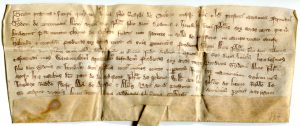
Preston Charter 9 Face.
Charters 5 and 7: Full Court Preston and Preston Take 2
- Charters 6 and 9: Preston Charters Continued
(Remember, Charter 8 is missing.)
Now we turn to others. Here we focus upon Charters 10 and 11.
Both of these are dated, like Charter 9; all 3 of these have dates within the reign of King Edward II, spaced at 4-year intervals. Charter 9, already examined (also see its image to the right here), is dated to Year 8 of the reign.
The Group of Preston Charters
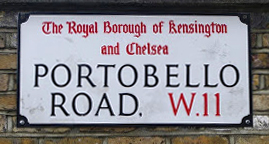

Church at Preston St Mary. Photograph by Andrew Hill via Wikimedia Creative Commons
The owner purchased the group of 9 documents in the 1980s in London, probably — according to his recollection — in the Portobello Road, a renowned location of markets and shops of many kinds, including used goods, curiousities, and antiquities. The group has a consecutive series of modern Arabic numbers, running from 5 to 13. The individual number is entered in black ink at the top left corner of the dorse (or back) of each document.
Of that original group, only 8 survive in the “Preston” collection, because Charter 8 went missing after a class some years ago, considerably before the group came into our view. Consequently, we know now only of Charters 5–7 and 9–13.
Charters 5 and 7 have figured already in 2 previous blogposts, with an introduction, photographs and descriptions, transcriptions and translations of their texts, and some observations about their characteristics and contexts (Full Court Preston and Preston Take 2). Next, Charters 6 and 9 took the stage (Preston Charters Continued).
We continue here to Charter the Course.
Now is the time for Charters 10 and 11. Both carry the dates of their transactions during the reign of King Edward II, who lived from 25 April 1284 – 21 September 1327, and reigned from 7 July 1307 until his deposition in January 1327.

London, British Library, Royal MS 20 A. II, folio 10r. Chronicle of England: Edward II receives his crown. Image Public Domain via Wikipedia.
The Lay of the Land
Within the group, each document has a mostly blank dorse, but for the owner’s inventory numbers in black ink and the sparse medieval or later docketing inscriptions. The face of each document is filled with the text of the transaction, laid out in a single column of long lines. The numbers of lines vary between 9 (Charter 9), 12 (3 charters), 13 (2 charters), 14 (Charter 11), and 16 (Charter 5) lines.
The documents in the set exhibit certain differences. 5 of them have more-or-less rectangular shapes, wider than tall. Charters 12 and 13 have rippled upper edges, corresponding to the chirographic method of producing an interlocking, and thereby identifiably identical, set of charter-plus-copy (or multiple copies) for the different parties to the transaction in question. [Now see Charter the Course: More on Preston Charters
For such a Chirograph, copied in duplicate (or more) upon a single sheet, the cut between them takes the form of a wavy edge; in Charter 12 it runs through an enlarged and spaced word — perhaps the Latin word chirographum, as customary? — to allow the copies to be matched physically as a safeguard against forgery.
Each document has a forward-facing fold at the bottom of its face. Each has a pendant tag of vellum to hold a seal. Some retain their wax seals, or parts thereof (Charters 7, 12, and 13). One (Charter 5) has a cloth pouch to protect the seal — however, now lost. At least 1 of the vellum tags (Charter 11) comprises a reused strip of already-written vellum. The tags on some documents (Charters 6 and 9–11) appear to have no traces of wax, so as never to have received seals. One tag reuses a discarded strip of already-written vellum (Charter 11).
Group Portrait
With the full group set out for examination, we offer their photographs from the back and the front. These group portraits demonstrate at a glance the varied sizes and shapes of the different charters, their styles of presentation, the shapes of their pendant tags, and the presence or otherwise of seals attesting to their authentication.
Seen from the Dorse
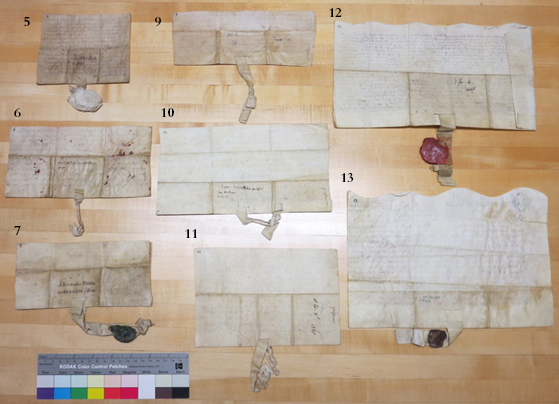
Preston Charters Dorses. Photograph Mildred Budny.
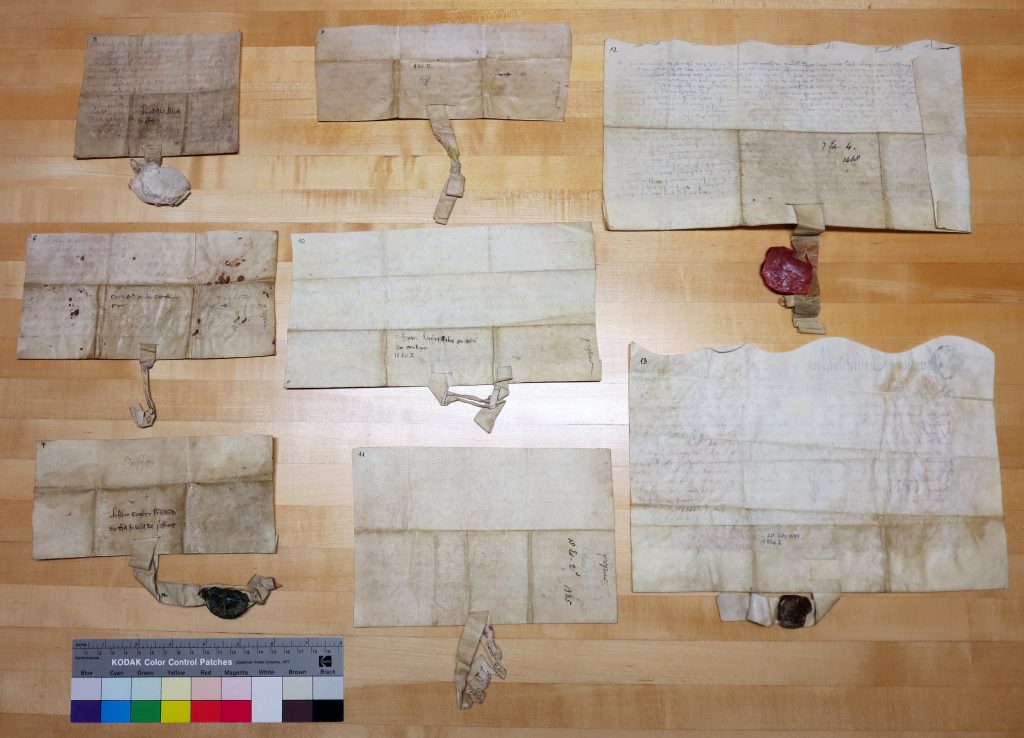
Preston Charters: Dorse with Guide. Photograph Mildred Budny.
Seen from the Face
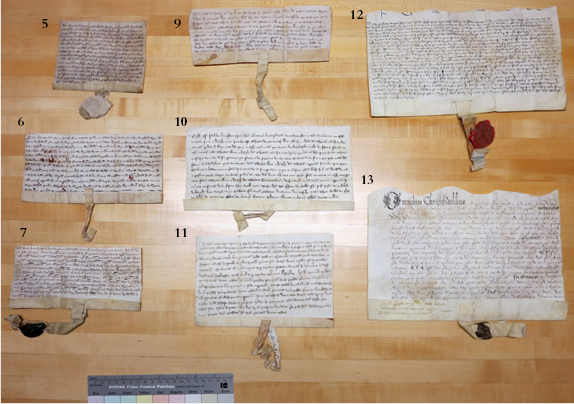
Preston Charters Faces. Photograph Mildred Budny.
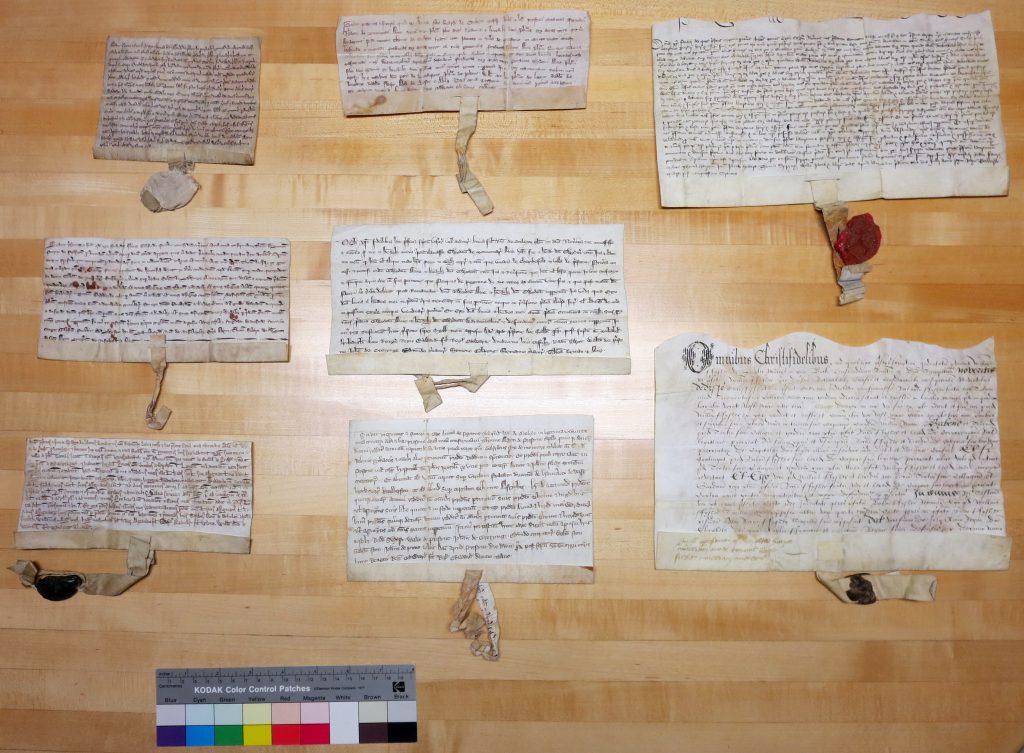
Private Collection, Group of 8 Preston Charters: Faces Forward. Photograph Mildred Budny.
Folds, Tags, Seals, and More
In preparing each document, as customary for such materials, the more-or-less rectangular sheet of vellum was folded horizontally once near the bottom, producing a flap or fold which turns inward to the side of the leaf intended to carry the text — usually the flesh side of the skin. Sometimes there is writing within that fold, sometimes not.
Around the flap, more or less at its center along the bottom edge of the document, a narrow strip of vellum is laced through a pair of horizontal slits (made across the flap and in the foldline) to form a looped or tied tail or tag. Sometimes this strip carries a seal of colored wax impressed or pressed in some way onto its extension from the document.
In some cases, the seal survives to some extent (Charters 7, 12, and 13). One case (Charter 5) retains the old, and perhaps original, cloth pouch designed to protect the seal, but the seal itself has disappeared following its removal through one or other hole cut in the cloth at the top and bottom.
The patterns of fold-lines and stains on each document demonstrate that, after completion with their written and attested texts, the single sheets were folded into smaller, block-like units, in which they were stored for a considerable period or periods of time. Mostly the sheets were folded horizontally once or twice, and then vertically into thirds, forming flaps to be turned over, one after the other, and presenting as the front of the unit the centered block at the base of the document, from which extends the vellum tail, with an optional seal. Brief docketing inscriptions are written in ink on the dorse, within that centered block and/or elsewhere.
One by One
Charters 5–9
Our earlier blogposts considered
- Charters 5 and 7 as a pair: Full Court Preston and Preston Take 2
- Charters 6 and 9 as a pair: Preston Charters Continued
Charter 8 is lost.
Charter 10
11 Edward II (= 8 July 1317 – 7 July 1318)
Deed for Land at Herschfeld in the Vill of Preston
From Anicia, Daughter of Richard of Ot(t)elye
To Gwyndon de Mortuomar and Alicia, His Wife
Dorse
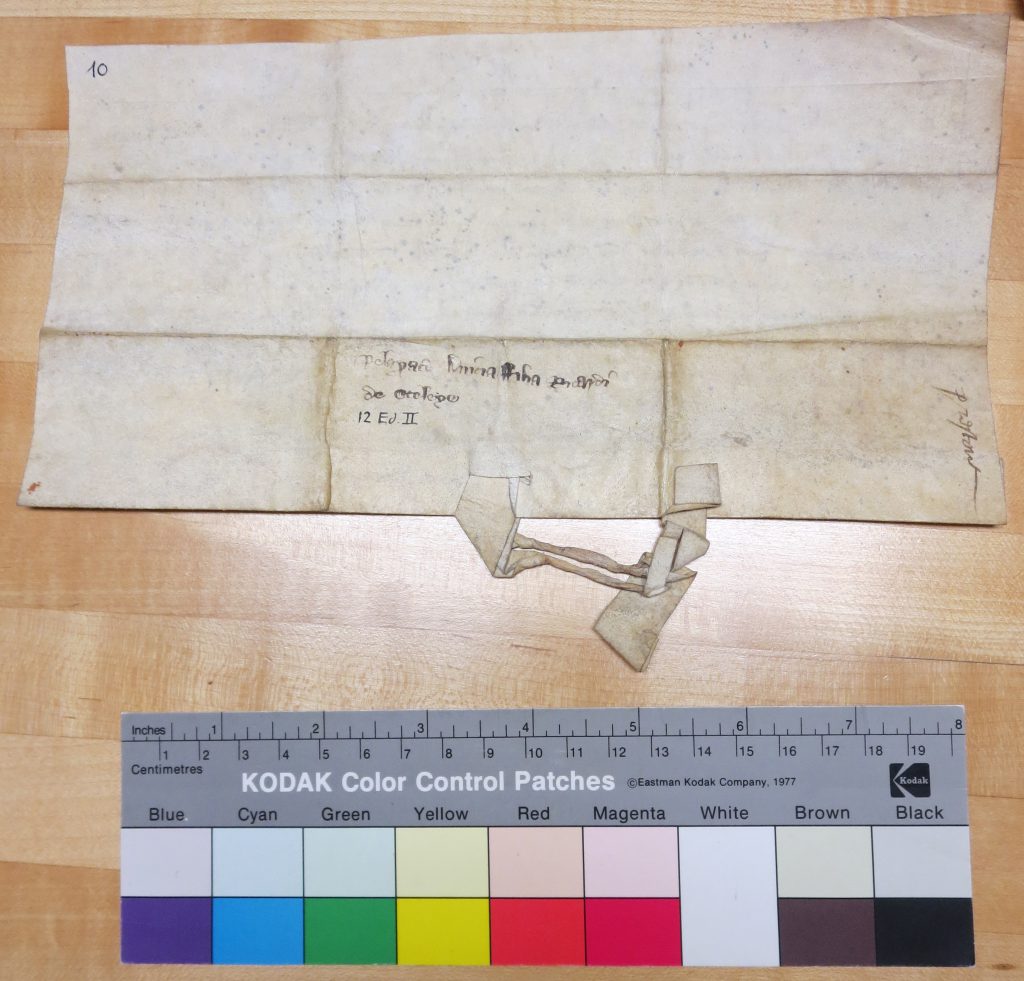
Preston Charter 10 Dorse. Photograph Mildred Budny.
The docketing inscriptions include the modern owner’s inventory number at the top left and the note of the date of the charter, as reckoned in

Preston Charter 10 Docketing: Preston.
regnal years. That note stands below the 2-line medieval inscription written unevenly in an unsteady hand naming the vendor and her father.
Pe???? Anicia filia Richardi / de Ottelee
Sideways at the right stands the rapidly written place name Preston ending in an extended “horizontal” stroke (viewed with the script upright).
Face

Preston Charter 10 Face. Photograph Mildred Budny.
The dating clause stands in the penultimate line: Anno Regni Regis Edwardi Filius Regis Edwardi duodecimo (“In the 12th year of the reign of King Edward, son of King Edward”).
Tag and Lifted Flap
There is no script in the interior of the foldline. The loose lacing of the tag through the fold allows for a full view of that “gutter”. Although made ready for a seal, the tag appears never to have had one.

Preston Charter 10 Face. Photograph Mildred Budny.
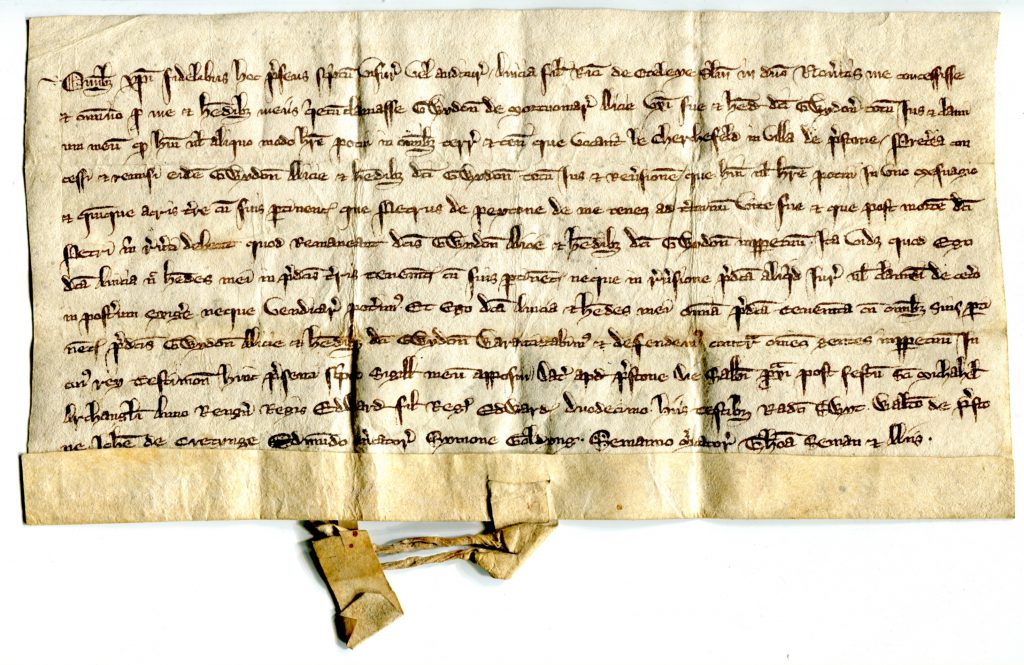
Preston Charter 10 Face.
*****
Charter 11
18 Edward II (= 8 July 1324 – 7 July 1325)
“Sunday after the Feast-Day of Saint Gregory the Great” [=18 March 1325]
From Anicia of Peyntone, Daughter of Roger of Ottelye
To Thomas Alayn of Preston
Dorse

Preston Charter 11 Dorse. Photograph Mildred Budny.
Docketing
Turned sideways at the right-hand side, the docketing inscriptions stand in a vertical row, with the medieval Preston at the outer edge. There follows, the pencil notation “Edw[d?] 2” and the staggered line in ink “18 Ed. 2d / 1325″.

Preston Charter 11 Dorse: Docketing. Photograph Mildred Budny.
Face

Preston Charter 11 Face. Photograph Mildred Budny.
The text begins:
Sciant praesens et future quod Ego Anicia de Pyntone filia quondam Rogeri de Ottelye. . . Thome Alayn de Prestone . . .
Thus we learn that Anicia’s father, defined as quondam (“formerly”), was no longer living.
The dating clause closes the charter with details of the place, day, and year:
Datum apud Prestone die dominicae px [partly cancelled with a pair of horizontal strokes and a superscript mark] post festinum sancti Gregorii Maioris /
Anno Regni Regis Edwardi filii Regis Edwardi decimo octavo.
This “18th regnal year” stood only 2 years away from the close of Edward’s reign, as he was deposed in January 1327, in his 20th regnal year. The feast-day of Gregory the Great was celebrated on 12 March (until the revision of the saints’ calendar for Western Christian usage in 1969). In 1325, 12 March occurred on a Monday. The Sunday after Gregory’s feast-day fell on the 18th.
Lifted Flap

Preston Charter 11 Face with Lifted Fold. Photograph Mildred Budny.
Like Charter 10 produced a few years previously within the same king’s reign (see above), this one has no script hidden in the foldline.
Reused Tag

Preston Charter 11 Face Tag.
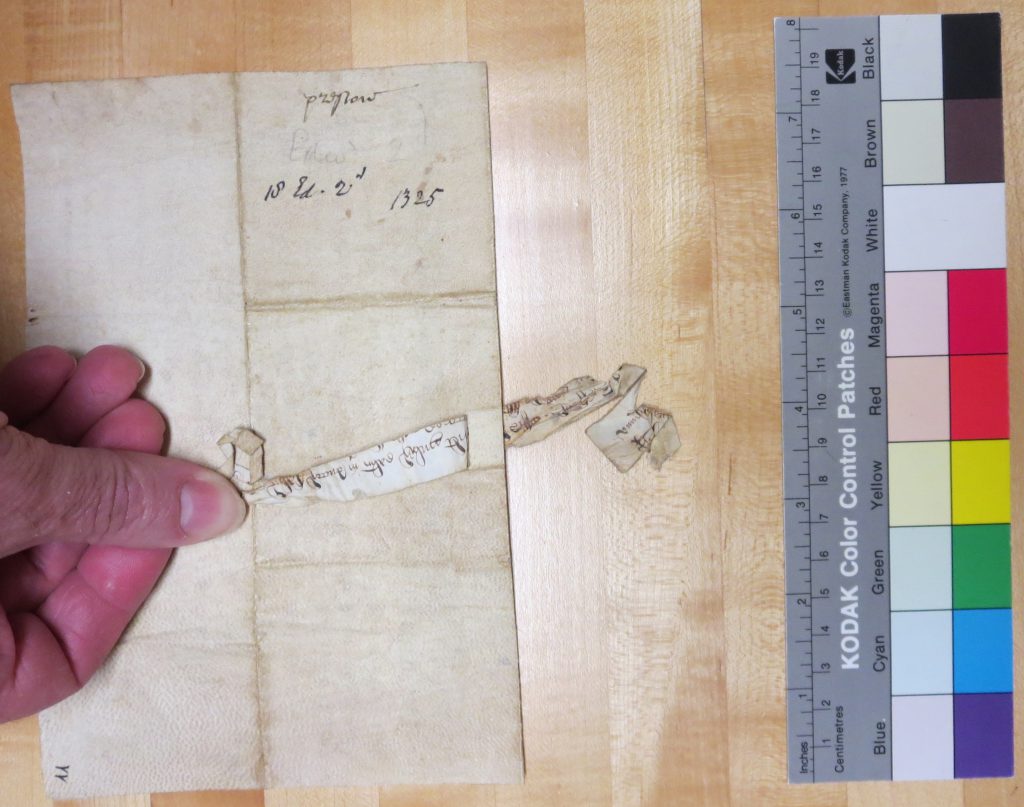
Preston Charter 11 Reused Tag. Photograph Mildred Budny.
Script of Reused Tag Turned Upright

Preston Charter 11 Reused Tag, with its Script turned Upright. Photograph Mildred Budny.
*****
Next stop: Another pair of Preston Charters.
[Update: Now see Preston Charters: The Chierographs.]
*****
